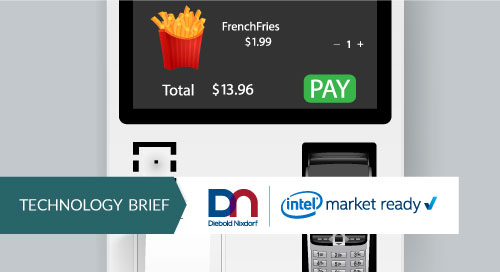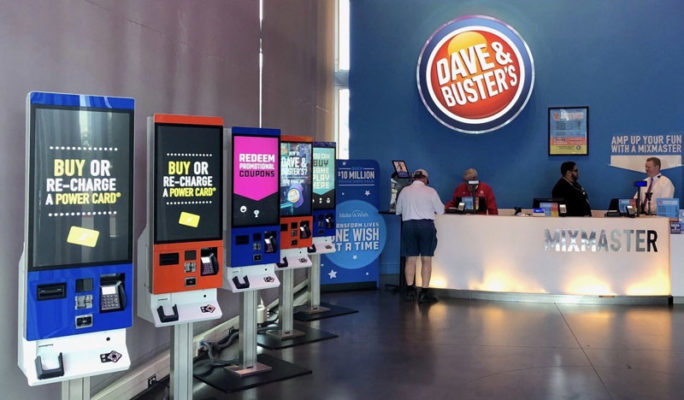The New Shopper Journey: Kiosks Add Delight

With retailers facing a difficult environment, business owners are asking, “How do I breathe new life into my stores?” It’s a good question. How do you modernize your processes to meet the fast-changing needs of your customers?
The best place to start is in the customer experience. In today’s climate, it’s important to remain adaptable and flexible to what customers want—and to really focus on those people. By carefully implementing solutions that meet your customers’ needs, you will be able to guide them through a rewarding shopper journey.
This might seem easier said than done. Consumers are dramatically changing their shopping habits, which makes it hard to predict what the future holds.
One way to navigate this path is to gain a deep understanding of your customers and empathize with what they are experiencing. Understanding and empathy are powerful tools to help you map a gratifying and delightful shopper journey. It’s also important to look at current trends in consumer behavior.
The Self-Service Trend
Self-service retail is one way to delight customers, increase sales, and provide more time for associates to focus on high-touch customer service—all at the same time. The trend toward self-service has been on the rise for several years, and has only been accelerated by the requirements of social distancing.
In 2019, a SOTI survey revealed that consumers prefer speed and convenience with limited human interaction when shopping. Additionally, almost 75 percent of the survey’s respondents were in favor of self-service technology to improve the retail customer experience.
Self-service is the new normal for retail. @DieboldNixdorf explains how this can actually boost sales and make customers happy. via @insightdottech
Customers prefer self-service options because they are faster, the line is usually shorter, and they are easy to use. Most consumers are happy to resolve issues and take care of things themselves. And the reduction in person-to-person contact can help customers feel more secure.
This opens up new opportunities for brands to delight customers in this new shopper journey. As speed and flexibility continue to be a high priority for customers, self-service options are likely here to stay (and grow).
Self-Service Kiosks Augment Today’s Shopping Experience
As the world increasingly moves toward a self-service culture, self-service kiosks can be a way to carefully implement a retail technology solution, which provides customer experiences that:
- Delight customers (fast and easy shopping)
- Optimize sales associates’ time (more time to focus on high-value tasks and personal customer service)
- Provide unparalleled analytics (mission-critical guest data collected from all connected kiosks)
- Trigger a significant increase in sales (larger ticket size)
Carl von Sydow, Director of Self-Service at Diebold Nixdorf, says, “We’ve believed in self-service kiosks for years. Retailers, like QSRs, have been getting 15 percent to 20 percent higher ticket sizes because of them.”
How Can Automation and Self-Service Be Powerful Tools for You?
Let’s take a deeper dive into the underlying reasons why customers prefer self-service kiosks. First, people don’t feel rushed when standing at a kiosk. They go at their own pace and make their own decisions. People like to feel empowered and have control of their journey.
Customers tend to browse the options on the screen and make new discoveries, which leads to an increase in ticket size. There’s also an opportunity for retailers to offer suggestions based on the customer’s basket, which offers yet another path leading to an increase in ticket size.
Next, when customers want to get in and out of a store quickly, the line at a self-service kiosk is usually shorter than the line at the counter. It’s a faster transaction when compared to interacting with a person. Plus, kiosks are easy to use. This will be amplified as people become even more accustomed to using them (Figure 1).

But this does not mean the sales associate’s job will become extinct. In fact, it’s quite the opposite. Staff journeys are also important. According to RIS, 53 percent of retail executives polled indicate that “empowering store associates” is one of their top-three priorities for 2020.
Self-service kiosks free up the sales associate’s time so he or she can focus on unique customer experiences and personalized solutions. By optimizing the associate’s time, that person can build relationships and become another helpful touchpoint on the shopper’s journey. There’s a misconception that self-service kiosks eliminate jobs. “It actually adds people in the end,” explains von Sydow.
Also, with the help of automation, self-service kiosks provide vital guest data that will allow you to further fine-tune your customer experience based on consumers’ needs. You can add targeted advertising to each kiosk’s monitor. This clear, concise messaging can be tailored for your guests. The retail data the kiosks provide simplifies A/B testing, which allows you to create an even more consistent and personalized experience at each kiosk.
Self-Service Kiosks Modernize QSRs
One of the most common use cases for self-service kiosks is in QSRs. Some of the largest chain restaurants in the world have enabled self-service kiosk solutions to make ordering faster and easier for their customers.
These kiosks have been successful in decreasing congestion while increasing sales and order accuracy. Additionally, these self-service kiosks offer a more personalized customer experience. With their incredible success, there’s no doubt self-service kiosks are modernizing and revolutionizing QSRs.
Diebold Nixdorf’s Award-Winning K-two Kiosk
Diebold Nixdorf’s K-two kiosk provides a 21st-century shopping experience across many use cases. You may have ordered food at your favorite QSR, ordered movie tickets, shopped in retail environments, and more on a K-two kiosk (Video 1).
Video 1. The K-two kiosk can transform the in-store experience. (Source: Diebold Nixdorf)
One K-two example is on display nationwide in Dave & Buster’s. According to the 2019 press release, this solution was “designed to meet Dave & Buster’s strategy of creating a more enhanced, efficient and engaging experience for consumers while they ‘Eat, Drink, Play and Watch.’” The Dave & Buster’s K-two has a 32-inch monitor and dispenses new Dave & Buster’s Power Cards and reloads existing cards instantly (Figure 2).

The efficiencies go even further thanks to the kiosk’s use of Intel vPro® technology, which enables large chains to manage and maintain all of their kiosks from a single pane of glass. Since all kiosks across any group of stores are interconnected, Diebold Nixdorf is able to provide managed services that include monitoring the kiosks and remote incident resolution. This is important, as availability and uptime are critical.
“For example, we can remotely update the software on all the kiosks. We can alert someone in the store if a kiosk goes down, if one of the EFTs is not properly connected, or if a monitor isn’t displaying correctly. In the case of Dave & Busters, we can notify a store associate if the cardholder in one of the kiosks is empty and needs to be resupplied,” von Sydow explains.
Just the Beginning
Consumers want self-service options, and retailers gain many benefits by providing them. This current environment has accelerated the adoption of self-service kiosks, which was already growing at a fast pace. This growth will only continue as customers look for the fastest, easiest way to get their in-store needs met.